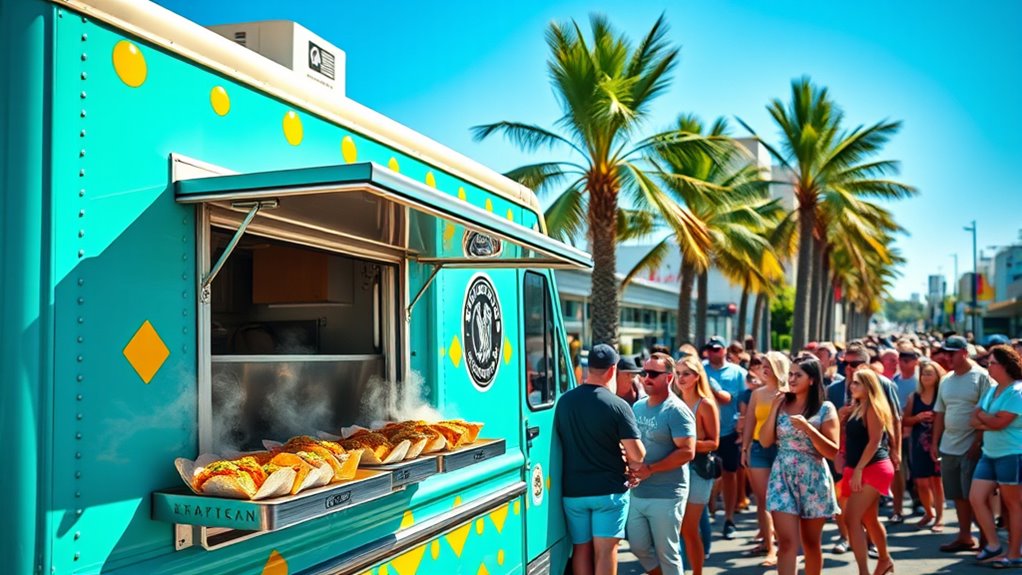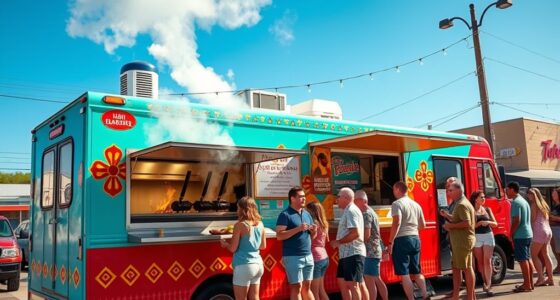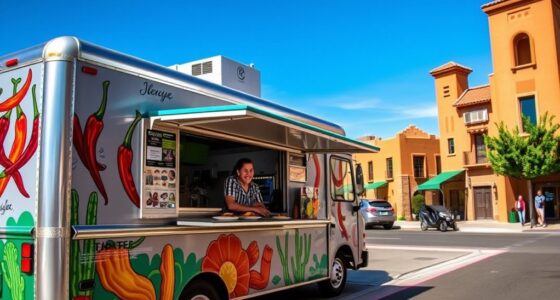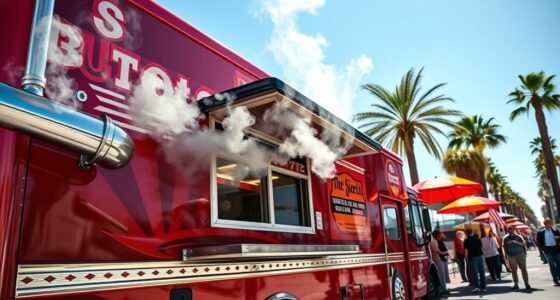To start a food truck in Tampa, FL, you need to develop a solid business plan, create a menu that highlights local flavors, and build a recognizable brand. Then, complete the online permit applications, pass health inspections, and verify your truck is parked legally in designated zones. Budget wisely for equipment, permits, and insurance, and consider using shared kitchens. Focus on marketing with local events and social media, and explore Tampa’s vibrant food scene. Learn more to start your journey!
Key Takeaways
- Develop a detailed business plan focusing on menu, branding, and financial goals tailored to Tampa’s local tastes.
- Complete Tampa’s online permit application, obtain necessary food safety inspections, and identify approved parking zones.
- Secure funding through small business loans, and acquire insurance coverage to protect against liabilities.
- Design a menu with local ingredients, calculate food costs accurately, and implement contactless payment technology.
- Engage with Tampa’s community via festivals, social media, and collaborations with local influencers to boost visibility.
Starting With a Business Plan

Creating a solid business plan is the essential first step when starting your food truck in Tampa, FL. Your plan should clearly outline your menu design, focusing on dishes that appeal to local tastes and stand out from competitors. Effective branding strategies are also key; they help establish your food truck’s identity and attract loyal customers. Think about your logo, color scheme, and overall vibe, ensuring they resonate with your target audience. A well-crafted business plan guides your decisions, from vehicle choice to marketing efforts, and sets realistic financial goals. By defining your brand early and designing an appealing menu, you’ll lay a strong foundation for your food truck’s success in Tampa’s vibrant food scene.
Understanding Local Requirements
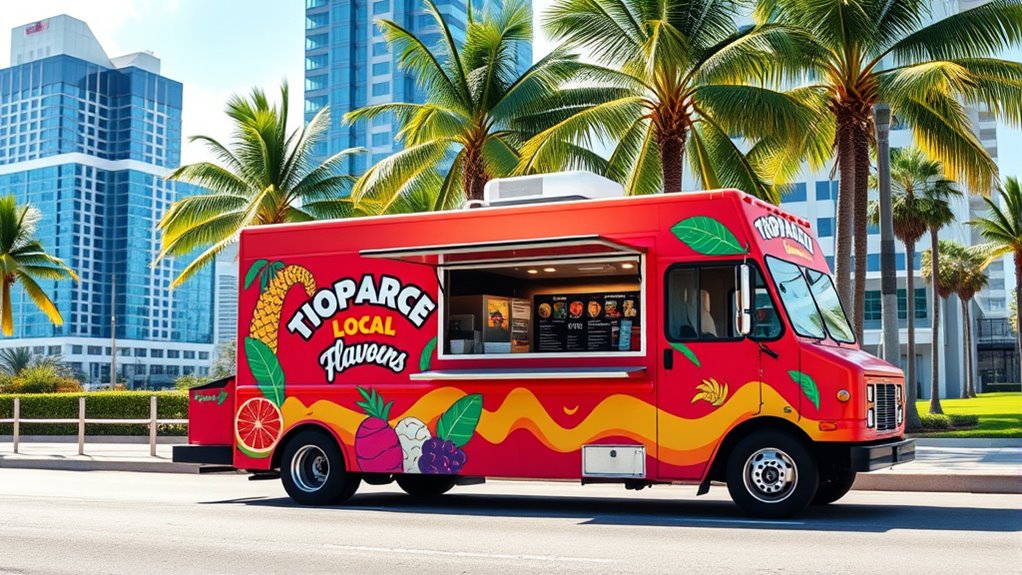
To get started, you’ll need to complete the online permit application and pass a food safety inspection using the checklist provided by Tampa authorities. Make sure you understand where you can park your truck by reviewing designated street zones to avoid fines. Staying compliant with these local requirements keeps your food truck legal and running smoothly.
Online Permit Application Process
Managing the online permit application process in Tampa requires understanding the city’s specific requirements for food trucks. To start, you’ll need to complete the permit process through the city’s online application system. This streamlined platform allows you to submit all necessary documents electronically, saving you time and effort. Before applying, make certain you have all the required information, such as your business license, vehicle details, and proof of insurance. Tampa’s online application system is user-friendly, but it’s essential to carefully follow each step to avoid delays. Once your application is submitted, you can track its status online and receive updates directly. Familiarizing yourself with Tampa’s permit process ensures a smooth start to launching your food truck and getting your business up and running efficiently.
Food Safety Inspection Checklist
Understanding Tampa’s food safety inspection requirements is essential for getting your food truck approved to operate. The inspection checklist ensures your truck meets local food safety standards and helps you avoid delays. Prepare by verifying that your truck has proper food storage, clean and sanitized surfaces, and correct temperature controls. You’ll also need to demonstrate safe handling practices and proper pest control measures. Key points to focus on include:
- Maintaining proper food storage and refrigeration
- Ensuring all surfaces are sanitized regularly
- Documenting staff training on food safety protocols
Following the inspection checklist diligently not only keeps your truck compliant but also promotes customer safety. Being thorough in these areas will make the inspection process smoother and set your food truck up for success.
Designated Street Parking Zones
Mastering Tampa’s street parking regulations is essential for operating your food truck legally and efficiently. Tampa designates specific parking zones where food trucks can park, and understanding these street regulations is crucial. You must identify authorized parking zones, which often include certain metered or permit-only areas. Parking outside these zones can lead to fines or your truck being towed. Before setting up, review local signage and regulations to guarantee compliance. Some zones may require special permits or limited parking times, so always verify rules beforehand. By adhering to designated street parking zones, you avoid violations and streamline your daily operations. Staying informed about Tampa’s parking regulations helps you serve customers smoothly while avoiding unnecessary penalties.
Setting Up Your Base of Operations
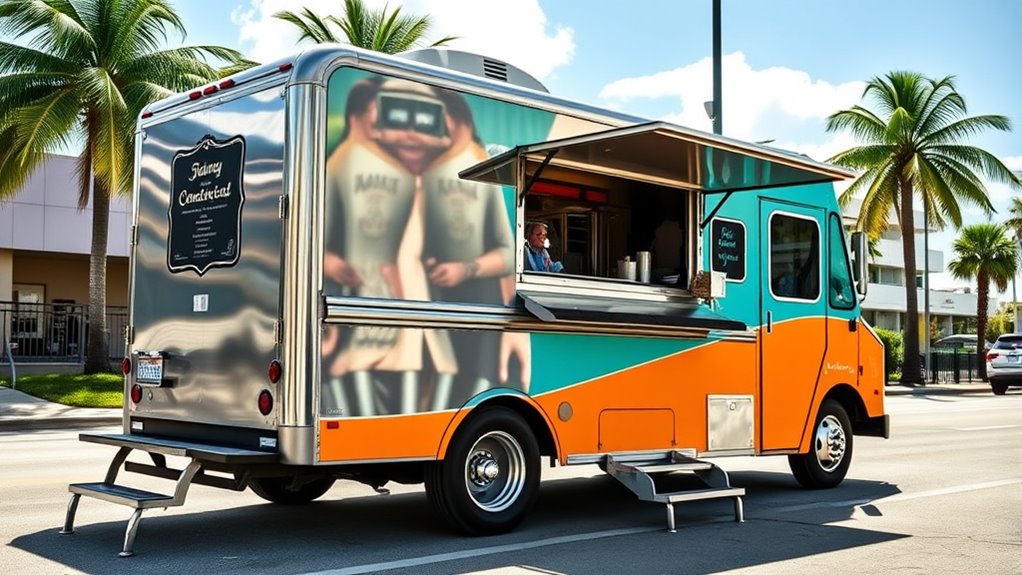
Choosing the right space is vital for your food truck’s success, and shared kitchen licensing options can be a smart, cost-effective solution. Planning your kitchen layout carefully guarantees you maximize efficiency and meet health regulations. By considering these factors, you’ll set a strong foundation for your operations. Additionally, understanding juice extraction techniques can help you incorporate fresh, nutrient-rich beverages into your menu, appealing to health-conscious customers.
Shared Kitchen Licensing Options
Setting up your base of operations through shared kitchen licensing options can save you time and money as you launch your food truck. Sharing a commercial kitchen allows you to obtain necessary permits without building your own facility. This option simplifies obtaining shared kitchen licensing and commercial kitchen permits, making compliance easier. By using a shared kitchen, you can:
- Minimize startup costs with affordable rental options
- Access fully equipped commercial kitchens without large investments
- Quickly meet health and safety regulations for permits
Shared kitchens help streamline the licensing process, ensuring you meet local health department standards efficiently. This approach reduces delays and allows you to focus on perfecting your menu and growing your business while maintaining proper licensing and permits.
Custom Kitchen Layout Planning
Designing a custom kitchen layout is a essential step in establishing a functional and efficient food truck. Your kitchen layout must maximize space, streamline workflow, and meet safety standards. Start by evaluating your menu and equipment needs, then plan the placement of appliances, prep areas, and storage. A well-thought-out custom design ensures smooth operations and quick service, which are indispensable for success. Use this simple table to visualize your layout options:
| Equipment | Placement |
|---|---|
| Grill and stove | Near prep station |
| Refrigerator | Close to cleaning |
| Prep tables | Central location |
This strategic approach helps you create a custom design that enhances productivity and meets Tampa’s food truck regulations.
Budgeting and Financing Your Food Truck

To start your food truck, you need to plan your budget carefully, especially for initial equipment costs and insurance. You might consider local small business loans to cover expenses and keep your cash flow steady. Protecting your truck with liability coverage is essential to avoid unexpected costs down the road. Additionally, understanding the potential pitfalls in adopting new payment technologies can help you choose secure and reliable merchant services that align with your business needs.
Initial Equipment Purchase Costs
Understanding your initial equipment purchase costs is essential for creating a realistic budget and securing financing for your Tampa food truck. Equipment costs vary depending on your menu and truck size but are a significant part of your startup budget. To stay on track, consider these key items:
- Commercial kitchen appliances, like ovens and refrigerators
- Cooking and prep equipment, such as grills and fryers
- Point-of-sale systems and storage solutions
Accurately estimating these costs helps you avoid surprises and ensures you have enough funds to cover essential gear. Keep in mind that quality equipment can be more expensive initially but may save money in the long run through durability and efficiency. Proper budgeting for equipment sets the foundation for a successful food truck business.
Local Small Business Loans
Securing a small business loan is often a essential step in funding your Tampa food truck startup. Small business funding options can help cover costs like equipment, permits, and initial inventory. To start, you’ll need to understand the loan application process, which typically involves preparing financial documents, a solid business plan, and demonstrating your ability to repay. Local lenders may offer favorable terms tailored to small businesses in Tampa. Be prepared to present clear financial projections and show that your food truck has growth potential. Applying for a loan can seem intimidating, but with thorough preparation and a strong application, you increase your chances of approval. Once funded, you’ll have the financial foundation to launch and grow your food truck business confidently.
Liability Coverage for Food Trucks
When budgeting for your Tampa food truck, factoring in liability coverage is just as important as securing funding. Liability insurance helps protect you from potential claims related to property damage, injuries, or accidents involving your truck. Meeting coverage requirements is essential to operate legally and safeguard your business assets. Without proper liability insurance, a single incident could threaten your financial stability. To ensure you’re adequately covered, consider these key points:
- Understand local coverage requirements to stay compliant.
- Choose a policy that covers bodily injury, property damage, and legal fees.
- Regularly review and update your liability coverage as your business grows.
Having the right liability insurance not only meets legal standards but also gives you peace of mind as you serve Tampa’s vibrant food scene.
Designing Your Menu and Pricing Strategy
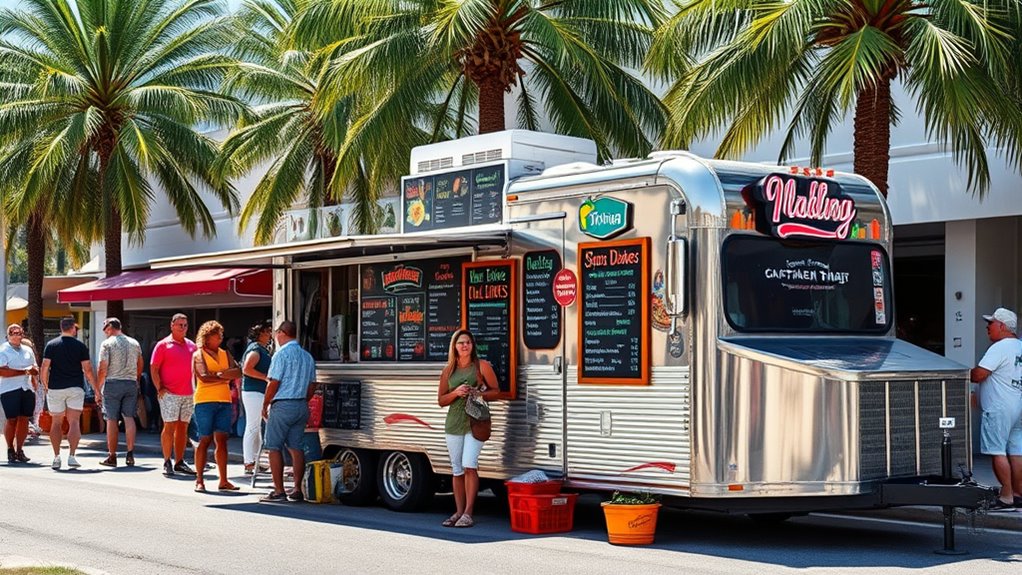
When designing your menu and setting prices, consider incorporating locally sourced ingredients to appeal to Tampa’s community. Calculating ingredient costs accurately helps you price your dishes competitively while maintaining quality. By balancing these factors, you can create a menu that attracts customers and keeps your business profitable. Additionally, understanding construction toys can inspire creative marketing strategies by highlighting the use of quality, educational, and engaging ingredients to appeal to families seeking wholesome options.
Locally Sourced Ingredient Integration
Incorporating locally sourced ingredients into your menu can set your food truck apart by highlighting freshness and community support. Establishing strong sourcing partnerships guarantees you get the best ingredients while fostering local relationships. This focus on ingredient freshness resonates with customers who value quality and sustainability. To maximize these benefits, consider:
- Building relationships with local farmers and vendors
- Highlighting seasonal menu items that showcase fresh, local produce
- Promoting your sourcing story to connect with customers emotionally
Ingredient Cost Calculation Methods
To develop a profitable menu and pricing strategy for your Tampa food truck, you need to accurately calculate ingredient costs. This begins with effective ingredient pricing, where you determine the true cost of each item used in your recipes. Accurate cost estimation involves tracking the purchase price of ingredients and dividing it by the number of units or servings it yields. For example, if you buy a bag of vegetables for $20 and it makes 10 servings, the ingredient cost per serving is $2. This method ensures you understand your expenses and helps set appropriate menu prices. Regularly reviewing ingredient prices allows you to adjust your pricing strategy as costs fluctuate, ensuring your food truck remains profitable and competitive in Tampa’s vibrant food scene.
Technology and Operations
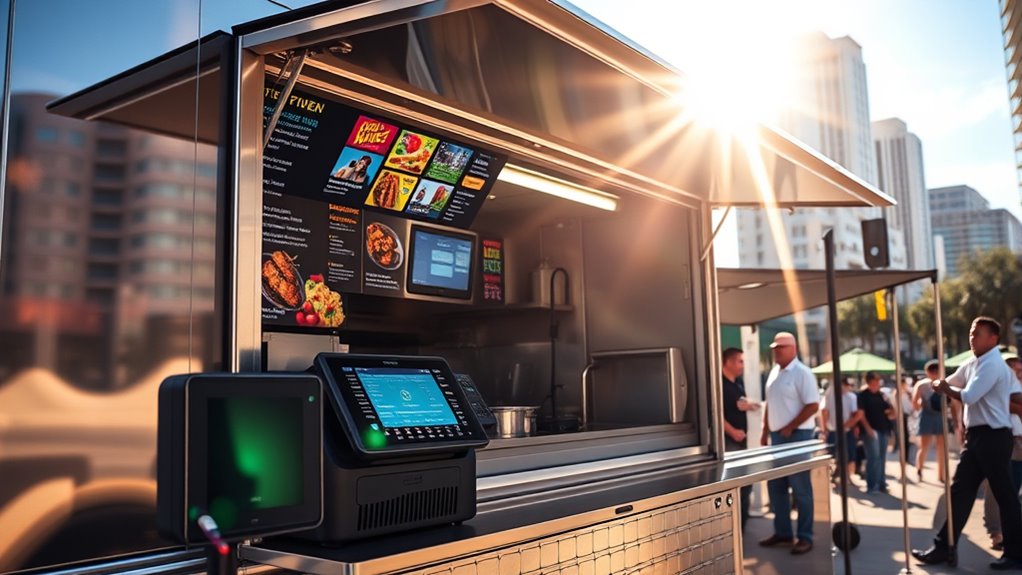
Implementing the right technology can streamline your food truck operations and improve customer experience. Contactless payment options make transactions faster and safer, while a mobile POS system helps you manage sales efficiently. Keep track of your inventory with stock tracking tools to avoid shortages and stay organized.
Contactless Payment Options Available
Contactless payment options are becoming essential for food trucks looking to improve customer convenience and streamline transactions. By accepting contactless payments, you can reduce wait times and enhance the overall experience. Digital wallets like Apple Pay, Google Pay, and Samsung Pay are popular choices that customers trust. Incorporating these options allows for quick, secure transactions without the need for cash or card swipes. To get started, consider these points:
- Invest in a compatible contactless payment terminal
- Promote digital wallet acceptance to attract more customers
- Confirm your Wi-Fi or data connection is reliable for smooth processing
Mobile POS and Stock Tracking
A mobile POS system streamlines your food truck operations by enabling you to process sales quickly and efficiently on the go. With a mobile POS, you can handle transactions seamlessly, reducing wait times and improving customer experience. It also integrates stock tracking, so you stay updated on inventory levels in real-time. This way, you know exactly when to reorder ingredients and avoid shortages during busy hours. Mobile POS systems often come with features like sales reporting and analytics, helping you make informed decisions. Plus, they can sync with your inventory management tools, ensuring your stock levels are always accurate. Implementing a mobile POS with stock tracking makes your operations smoother, more organized, and better prepared to serve your customers in Tampa.
Marketing and Growing Your Presence

To grow your food truck’s presence in Tampa, focus on popular local event venues where crowds gather. Connecting with local food bloggers can also boost your visibility and attract new customers. These strategies help you build a loyal following and expand your reach effectively. Considering the use of smart home device integration for your business operations can also improve efficiency and customer engagement.
Popular Local Event Venues
Leveraging popular local event venues in Tampa is essential for boosting your food truck’s visibility and attracting new customers. These venues offer prime opportunities to showcase your food truck branding and connect with a broader audience. By participating in events like festivals, farmers’ markets, and community gatherings, you can build a loyal customer base. To maximize your presence:
- Engage attendees with eye-catching signage and branded merchandise
- Use social media marketing to promote your location and daily specials
- Offer exclusive event discounts to encourage repeat visits
Attending these venues helps you establish a strong local presence and creates buzz around your food truck. Consistently showing up at popular spots can turn casual passersby into loyal customers, fueling growth and increasing your reputation in Tampa’s vibrant food scene.
Engaging Local Food Bloggers
Partnering with local food bloggers can considerably boost your food truck’s visibility in Tampa’s crowded scene. Focus on food blogger outreach by identifying popular bloggers who align with your cuisine and target audience. Invite them to try your menu and share their honest reviews. Social media collaborations are also powerful tools—coordinate with bloggers to feature your truck on their platforms, creating engaging content that reaches a broader audience. Make sure to provide high-quality photos and behind-the-scenes glimpses to encourage shares and comments. Building genuine relationships with local bloggers can lead to ongoing promotion and increased foot traffic. By actively engaging with these influencers, you’ll amplify your presence in Tampa’s vibrant food scene and attract loyal customers.
Navigating Tampa’s Food Scene

Exploring Tampa’s vibrant food scene requires understanding its diverse culinary landscape and local preferences. To succeed, immerse yourself in key events and local hotspots. Attend local food festivals to connect with community tastes and stay current on trending flavors. Explore Tampa street art to discover neighborhoods with unique cultural identities, inspiring your menu and branding. Engage with residents to learn their favorite spots and hidden gems. Keep an eye on social media for pop-up events and collaborations. Consider these strategies:
- Participate in local food festivals to showcase your truck
- Visit Tampa street art locations for inspiration and networking
- Join community events to build relationships and brand visibility
Additionally, understanding the local aesthetic can help you design your food truck to appeal visually to Tampa’s diverse audience.
Frequently Asked Questions
What Permits Are Needed for Street Vending in Tampa?
You’ll need food truck permits and must comply with Tampa’s street vending regulations. First, obtain a mobile food dispensing vehicle permit from the Florida Department of Business and Professional Regulation. Then, secure a Tampa street vendor’s permit through the city’s Business Tax Division. Make sure your truck passes health inspections and adheres to zoning laws. Staying updated with local regulations guarantees smooth vending and avoids fines.
How Can I Find the Best Locations for My Food Truck?
To find the best locations for your food truck, explore popular park locations and event venues in Tampa. Visit these spots during peak hours to gauge customer traffic and preferences. Attend local events to network and discover high-traffic areas. Use social media to promote your location updates, and consider asking for feedback from customers. Consistently monitoring these areas helps you identify prime spots with the most potential for success.
Are There Specific Health Regulations Unique to Tampa?
Yes, Tampa has specific health regulations you need to follow for your food truck. You’ll need to pass local health inspections that focus on Tampa food safety standards. These inspections ensure your truck meets sanitation, food handling, and storage requirements. It’s essential to stay updated with Tampa’s health department guidelines, as they can change. Regularly review local health regulations to maintain compliance and avoid fines or shutdowns.
What Are Common Challenges Faced by Tampa Food Truck Owners?
You’ll face challenges like seasonal fluctuations in customer traffic, especially during off-peak months, which can impact profits. Equipment maintenance is also essential; neglecting it can lead to costly breakdowns. Managing permits and health regulations adds to the workload, while finding reliable staff can be tough. Staying adaptable and proactive helps you navigate these hurdles, ensuring your Tampa food truck stays successful year-round despite these common challenges.
How Can I Build a Loyal Customer Base in Tampa?
You can build a loyal customer base in Tampa by becoming a social media superstar—posting mouthwatering photos, engaging stories, and irresistible specials daily. Focus on customer engagement by chatting with followers and encouraging feedback. Attend local events consistently, making your truck the talk of the town. Offer loyalty programs that make customers feel like VIPs, turning first-time visitors into lifelong fans who can’t resist returning.
Conclusion
Starting your food truck in Tampa is like planting a seed—you’ll need careful planning, dedication, and a bit of creativity. By following these steps, you’ll build a vibrant presence in Tampa’s bustling food scene. Keep adapting and engaging with your community, and watch your truck thrive like a well-tended garden. With passion and persistence, you’re set to turn your culinary dreams into a delicious reality on Tampa’s lively streets.
